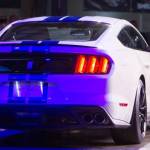Ford's choice of venue for unveiling the new Shelby GT350 Mustang couldn't have been more appropriate: Shelby International, the house that Carroll built. Flanked by six original GT350s--Ol' Shel's lightweight, high-revving road racers--the newest Mustang's debut wasn't just an unveiling. It was a homecoming.
It's finally here. Say hello to the all-new 2016 Ford Mustang Shelby GT350, which picks up where the the 2013 Boss 302 left off, and positions itself to be best-ever example of the ponycar, period. For those of you who are sitting there thinking the GT350 is just a GT500 replacement, think again.
The outgoing Shelby GT500 was all about violent, face-flattening velocity, teaming 662 supercharged horses with a solid rear axle. Ford's newest Shelby takes an entirely different approach. Based on the latest "S550" Mustang chassis, it wears a fully independent rear suspension and builds on that with magnetorheological dampers, unique, aero-uber-alles bodywork, and a naturally aspirated 5.2-liter V8 with the long-rumored flat-plane crankshaft. It's a thoroughly modern pony built for racetracks with apexes instead of those with burnout boxes.
The V8 engine skips forced induction entirely in favor of a sky-high redline--8200 RPM--and that fancy flat-plane crank, like you might find in a Ferrari. For those unfamiliar, a flat crankshaft design involves attaching the crank pins at 180-degree intervals rather than the usual 90; this allows for a firing order that bounces back and forth between the two cylinder banks with little to no overlap in exhaust pulses. Jalopnik gives an in-depth article about flat-plane cranks and the roar they produce.
The engine breathes better as a result, and Ford says that this 5.2 is the most powerful naturally aspirated engine the company has ever produced. Final output is still under wraps, but Ford says we should expect more than 500 horsepower and 400 lb-ft of torque. For comparison, the Boss 302 made 444 horses and 380 lb-ft from a naturally aspirated 5.0-liter V8, and the new Mustang GT gets 435 and 400 from its updated 5.0.
That power is sent to the rear wheels via a six-speed manual gearbox and a Torsen limited-slip differential. And as this is intended to be the track-friendly 'Stang, Ford has given the Pony a jolly good fettle underneath. Compared to the Mustang GT, the track is wider, the ride height lower, and the spring rates re-calibrated.
Bringing things to a stop are 394mm discs and six-piston callipers at the front, with 380mm discs and four-piston callipers at the rear. Slotting over those brakes are a set of 19-inch alloy wheels, which are wrapped in super-sticky Michelin Pilot Super Sport rubber.
If there's anything flat-crank engines are known for beyond big revs and a bunch of power, it's their unique sound. On this point, Ford promises we won't be disappointed: "Make no mistake, this is an American interpretation of a flat-plane crankshaft V8, and the 5.2-liter produces a distinctive, throaty howl." The only transmission this engine can be paired with is a six-speed manual. Output is then routed to a standard-equipment Torsen limited-slip differential; a diff cooler can be ordered, and it feeds on airflow directed from the rear diffuser.
//platform.vine.co/static/scripts/embed.js
The GT350 is the first Mustang ever to achieve zero aero lift. That's thanks to the aero work the company did to the GT350: the ducted belly pan, the front splitter, and the reduced ride height compared to a normal Mustang. Even the hood ducts are engineered to reduce lift at high speed. The hood was also lowered, which meant that engineers had to construct a new short-strand nylon carbon composite brace that serves as the radiator core support and braces the front end. The engineers left it exposed, and also won't hide away the V8 with a plastic cover. Both are functional art, and both should be seen.
As mentioned, the new Shelby features MagneRide, Ford's first-ever application of the continuously controlled magnetorheological damping system. This setup alters shock stiffness at each corner independently every 10 milliseconds based on the car's yaw angle and suspension load. The GT350 joins various General Motors vehicles--including the Corvette and the Camaro ZL1--the Audi TT and R8, and multiple Ferraris in offering the technology. In the Shelby, the suspension can be cycled through five modes, which also control steering effort, throttle sensitivity, the exhaust, and programming of the ABS and traction- and stability-control systems.
Compared with the regular Mustang GT, the Shelby has tweaked springs and bushings, a wider front track, and a ride height lowered by an as-yet-unspecified amount. The new Mustang is already a stiff piece, but Ford says rigidity is bolstered here by an injection-molded carbon-fiber-composite grille surround--yes, really, although we're a bit dubious of its effectiveness--and an optional lightweight strut-tower brace.
Unlike the carbon-ceramic-brake-equipped Camaro Z/28, Ford opted for two-piece iron rotors with aluminum hats for the GT350. They ought to deliver stupefying deceleration all the same, as they measure 15.5 inches up front and 15.0 inches at the rear. Six-piston Brembo calipers squeeze the front discs, while four-piston units are installed at the rear. The new Shelby rolls on 19-inch aluminum wheels--10.5 inches wide up front and 11 inches wide out back; ultra-sticky Michelin Pilot Super Sport rubber with a GT350-specific tread face, sidewall construction, and compound is standard.
As for aesthetics, everybody panel forward of the A-pillar is unique to the GT350, with a lower, steeper aluminum hood designed to more tightly hug the engine below. A large central heat extractor maximizes underhood airflow and is said to reduce front-end lift.
Aluminum front fenders with larger flares cover the Shelby's wider rolling stock, while inner and outer fender venting extracts air from the wheel wells and sends it down the car's flanks. Inlets in the front fascia send air to the front brakes and--with the available Track Pack--to optional coolers for the transmission and engine oil. An aggressive Shelby-labeled front splitter will help downforce and make parking-lot curbing a headache. There's a low-profile decklid spoiler, an underbelly aero tray, and the aforementioned rear diffuser, too.
Inside, Recaro sport seats and a flat-bottom steering wheel remove all doubt as to the car's mission, and the instrument panel sports reduced brightwork to cut down on glare. An optional Tech Pack brings power seat adjustment and leather upholstery, dual-zone automatic climate control, upgraded Shaker audio, and the eight-inch MyFord Touch infotainment screen.
The 2016 Mustang GT benchmarked the old Boss 302 during its development, and the all-new pony delivered on that promise, jousting with Porsche and Ferrari as a finalist in our 2015 Performance Car of the Year testing. The Shelby GT350 is set to redefine everything we ever knew about not just the Mustang, but pony cars in general--Z/28 be damned.
Source: Sorokanich, Robert. "2016 Ford Mustang Shelby GT350 unveiled, ready to hunt Z/28s." Car and Driver. 17 Nov 2014.
Source: Kierstein, Alex. "The 2016 Ford Mustang Shelby GT350 has an 8200 RPM redline." Road & Track. 17 Nov 2014.
Source: Robinson, Matt. "Ford's Snarling 500bhp+ Mustang GT350 Is Here." Car Throttle. 18 Nov 2014.













